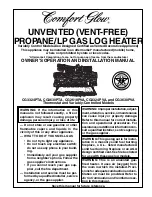
I-40 Manual and Spark Ignition
Owner’s Manual • I-40
7
■
Propane gas and natural gas have a distinctive
odor. Learn to recognize these odors. (Reference
“Fuel Gas Odor” and “Odor Fading” sections
above.
■
If you have not been properly trained in repair and
service of propane gas and natural gas fueled
heaters, then do not attempt to light the heater,
perform service or repairs, or make any adjust-
ments to the heater on a propane gas or natural
gas fuel system.
■
Even if you are not properly trained in the service
and repair of radiant heaters, ALWAYS be con-
sciously aware of the odors of propane gas and
natural gas.
■
A periodic “sniff test” around the heater or at the
heater’s joints; i.e. hose, connections, etc., is a
good safety practice under any conditions. If you
smell even a small amount of gas, CONTACT
YOUR FUEL GAS SUPPLIER IMMEDIATELY. DO
NOT WAIT!
1. Do not attempt to install, repair or service this
heater or the gas supply line unless you have
continuing expert training and knowledge of gas
heaters.
QUALIFICATIONS FOR SERVICING AND
INSTALLATION:
a. To be a quali
fi
ed gas heater service person, you
must have been trained in gas-
fi
red heater servic-
ing, repair and also have suf
fi
cient experience to
allow you to troubleshoot, replace defective parts,
and test heaters in order to get them into a continu-
ing safe and normal operation condition. You must
completely familiarize yourself with each model
heater by reading and complying with the safety
instructions, labels, owner’s manual, etc. that is
provided with each heater.
b. To be a quali
fi
ed gas installation person, you must
have suf
fi
cient training and experience to handle
all aspects of installing, repairing and altering gas
lines, including selecting and installing the proper
equipment, and selecting proper pipe size to be
used. This must be done in accordance with all
local, state and national codes as well as the
manufacturer’s requirements.
2. All installations or applications of L. B. White Co.,
Inc.’s radiant heater shall meet the requirements
of local, state and national L.P. gas and natural
gas, electrical and safety codes. Your gas supplier,
local licensed electrician, local
fi
re department
and government agencies can help you determine
these requirements.
3. If at any time you notice something unusual about
the operation of your heater such as gas odor,
overheating,
fl
ames other than in the combustion
cone area, etc., evacuate the area immediately
and call your
fi
re department and your gas service
agency. Get assurances from the
fi
re department
that the area is free of gas before you attempt to
relight the heater.
4. The components on the heater that call for hand
operation should work with hand pressure only. If
more force is required, have a quali
fi
ed gas heater
service agency replace the complete part. Do not
attempt to repair.
5. This heater is intended for the heating of livestock
in agricultural animal con
fi
nement buildings only.
The heater shall only be mounted inside the animal
con
fi
nement building. It shall not be used for
outside heating applications.
6. Do not locate fuel gas containers or fuel supply
hoses anywhere within the heating zone of the
heater.
7. Do not block the air intake, or burner emitter area.
Doing so may cause improper combustion or
damage to the heater components, leading to
property damage or animal loss.
8. Do not move, handle, or service the heater while in
operation or connected to fuel supply.
9. The hose assembly must be inspected on a regular
basis. This should be done at least once a year,
or when the building is cleaned out. If it is evident
there is excessive abrasion or wear, or if the hose
is cut, it must be replaced prior to heater being
put into operation. The hose assembly shall be
protected from animals, building materials, and
contact with hot surfaces during use. The replace-
ment hose assembly shall be that speci
fi
ed by the
manufacturer. See parts list.
Attention - Critical
Points to Remember!








































